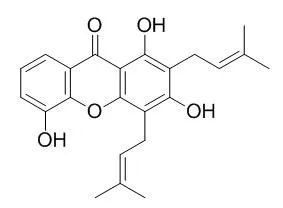| Kinase Assay: |
| Biomed Res Int. 2013;2013:715603. | | Altered mRNA expression related to the apoptotic effect of three xanthones on human melanoma SK-MEL-28 cell line.[Pubmed: 24175297 ] | We previously demonstrated that α-mangostin, γ-mangostin, and 8-Deoxygartanin have significant cytotoxic effects on human melanoma SK-MEL-28 cell line. The current study revealed the underlying mechanisms.
METHODS AND RESULTS:
α-Mangostin (7.5 μg/mL) activated caspase activity, with a 3-fold and 4-fold increased caspase 8 and 9 activity, respectively. The molecular mechanisms were investigated by qRT-PCR for mRNA related to cell cycle arrest in G1 phase (p21(WAF1) and cyclin D1), apoptosis (cytochrome C, Bcl-2, and Bax), and survival pathways (Akt1, NFκB, and IκBα). α-Mangostin significantly upregulated mRNA expression of cytochrome C and p21(WAF1) and downregulated that of cyclin D1, Akt1, and NFκB. γ-Mangostin significantly downregulated mRNA expression of Akt1 and NFκB and upregulated p21(WAF1) and IκBα. 8-Deoxygartanin significantly upregulated the mRNA expression of p21(WAF1) and downregulated that of cyclin D1 and NFκB. The three xanthones significantly inhibited the mRNA expression of the BRAF V600E mutation. Moreover, α-mangostin and γ-mangostin significantly downregulated Akt phosphorylation at Ser473.
CONCLUSIONS:
In conclusion, the three xanthones induced an inhibitory effect on SK-MEL-28 cells by modulating the molecular targets involved in the apoptotic pathways. |
|
| Cell Research: |
| Food Chem Toxicol. 2011 Sep;49(9):2385-91. | | Cytotoxic effect of xanthones from pericarp of the tropical fruit mangosteen (Garcinia mangostana Linn.) on human melanoma cells.[Pubmed: 21723363] | Mangosteen (Garcinia mangostana Linn.) is a tropical tree from South East Asia and its fruit pericarp is a well-known traditional medicine.
METHODS AND RESULTS:
In this study, the cytotoxic effect of three xanthone compounds (α-mangostin, γ-mangostin, and 8-Deoxygartanin) from mangosteen pericarp was investigated using the human melanoma SK-MEL-28 cell line. Significant dose-dependent reduction in % cell viability was induced. γ-Mangostin and 8-Deoxygartanine at 5 μg/ml increased the cell cycle arrest in G(1) phase (90% and 92%) compared with untreated cells (78%). All compounds induced apoptosis, of the highest being α-mangostin at 7.5 μg/ml that induced 59.6% early apoptosis, compared to 1.7% in untreated cells. The apoptotic effect of α-mangostin was via caspase activation and disruption of mitochondrial membrane pathways as evidenced by 25-fold increased caspase-3 activity and 9-fold decreased mitochondrial membrane potential when compared to untreated cells.
CONCLUSIONS:
In conclusion, these xanthones, especially α-mangostin, are potential candidates as anti-melanoma agents. | | J Nat Prod. 2009 Nov;72(11):2028-31. | | Cytotoxic xanthone constituents of the stem bark of Garcinia mangostana (mangosteen).[Pubmed: 19839614 ] |
METHODS AND RESULTS:
Bioassay-guided fractionation of a chloroform-soluble extract of Garcinia mangostana stem bark, using the HT-29 human colon cancer cell line and an enzyme-based ELISA NF-kappaB assay, led to the isolation of a new xanthone, 11-hydroxy-3-O-methyl-1-isomangostin (1). The structure of 1 was elucidated by spectroscopic data analysis. In addition, 10 other known compounds, 11-hydroxy-1-isomangostin (2), 11alpha-mangostanin (3), 3-isomangostin (4), alpha-mangostin (5), beta-mangostin (6), garcinone D (7), 9-hydroxycalabaxanthone (8), 8-Deoxygartanin (9), gartanin (10), and cratoxyxanthone (11), were isolated.
CONCLUSIONS:
Compounds 4-8 exhibited cytotoxicity against the HT-29 cell line with ED50 values of 4.9, 1.7, 1.7, 2.3, and 9.1 microM, respectively. In an ELISA NF-kappaB assay, compounds 5-7, 9, and 10 inhibited p65 activation with IC50 values of 15.9, 12.1, 3.2, 11.3, and 19.0 microM, respectively, and 6 showed p50 inhibitory activity with an IC50 value of 7.5 microM. Alpha-mangostin (5) was further tested in an in vivo hollow fiber assay, using HT-29, LNCaP, and MCF-7 cells, but it was found to be inactive at the highest dose tested (20 mg/kg). |
|






 Cell. 2018 Jan 11;172(1-2):249-261.e12. doi: 10.1016/j.cell.2017.12.019.IF=36.216(2019)
Cell. 2018 Jan 11;172(1-2):249-261.e12. doi: 10.1016/j.cell.2017.12.019.IF=36.216(2019) Cell Metab. 2020 Mar 3;31(3):534-548.e5. doi: 10.1016/j.cmet.2020.01.002.IF=22.415(2019)
Cell Metab. 2020 Mar 3;31(3):534-548.e5. doi: 10.1016/j.cmet.2020.01.002.IF=22.415(2019) Mol Cell. 2017 Nov 16;68(4):673-685.e6. doi: 10.1016/j.molcel.2017.10.022.IF=14.548(2019)
Mol Cell. 2017 Nov 16;68(4):673-685.e6. doi: 10.1016/j.molcel.2017.10.022.IF=14.548(2019)